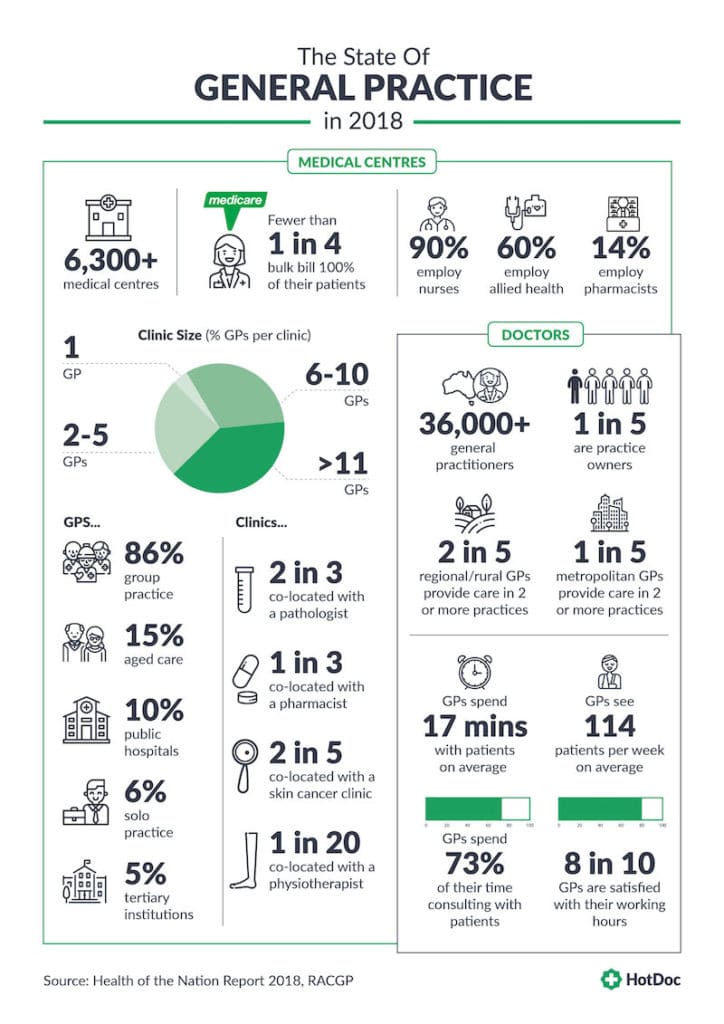In September, RACGP released their Health of the Nation 2018 report. The report showcases data collected from an online survey of 1,537 RACGP Fellows, as well as data publicly available through sites, such as the Australian Bureau of Statistics.
Being a rather dense report, we decided to extract some of the key points to make it easy for those in a rush. What follows is a brief overview of some of the headlines in a video and written article as well as an infographic that provides a pictorial overview of the current state of Australian general practice in 2018.
Video: Some highlights from RACGP’s Health of the Nation 2018 report
Mental health GPs’ biggest concern
If there was one headline to be drawn from RACGP’s 2018 Health of the Nation report, it would be that mental health is the number one concern for both GPs and patients. Mental health has become such a big problem — with 62% of patients talking to their GP about psychological issues — that we decided to write an independent piece solely on the state of mental health in 2018.
You can read the full post here: An Examination of Australia’s Mental Health in 2018: A Summary for General Practice
Patients review GPs positively
RACGP found overwhelmingly positive feedback from patients about their GPs. In spite of the fact that on average GPs see a whopping 114 patients per week — spending about 17 minutes per patient — they do a phenomenal job of making their patients feel listened to and well-cared for. For instance, 3 in 4 Australian patients report their GP always listens carefully, shows them respect and spends enough time with them.
Most Australians have a regular GP
More than three-quarters of Australians (78.2%) report having a preferred GP they see. According to the most recent Australian Institute of Health and Welfare (AIHW) report, as patients age, this number grows even higher with virtually all Australians over the age of 45 (98%) reporting they have a regular GP or practice.
“Still, the RACGP has flagged fragmentation of care as a growing concern, saying “there are currently no formal mechanisms in place to encourage continuity of care.”
The report shows that while many patients have a usual GP, around 1 in 4 patients attend multiple general practices. The RACGP has taken the findings so seriously that a month after releasing their Health of the Nation report they published an article on strategies to encourage continuity of care in the modern health system.
Video: An explainer of HotDoc Inform, which helps clinics encourage continuity of care by sending preventative health messages to patients
GPs say Medicare rebates top priority
When GPs were asked which health policy issue the federal government should make their top priority, 24% said Medicare rebates, 13% mental health and 14% obesity. The next most important issues were aged care services, drug addiction and health equity.
Most patients visit a GP multiple times a year
Most Australians (87%) visit their GP at least once a year and more than 4 out of 5 patients (84%) report they see their GP multiple times a year. Of that group, a significant number (12%) visit their GP 12 or more times a year.
The report also shows patients who visit their GP more than once a month tend to be older and less wealthy. Typically, they have a long-term health condition. For instance, 90% of patients who visit their GP more than once a month have a condition like cancer, arthritis, osteoporosis, asthma, diabetes or a mental health condition.
You can read more about frequency of visits in this article: How Often Do Australian Bulk Billed Patients Visit Their Doctor?
Work-life balance
GPs are largely satisfied with their work.
“89% of GPs say they are satisfied with their job all things considered. Of these, 42% are very satisfied and 47% are moderately satisfied.”
Clinic size appears to have an affect on satisfaction. GPs who are very dissatisfied with their work tend to reside in practices with fewer GPs.
When it comes to work hours, 85% of GPs say they are satisfied with their work hours. Contracted employees tend to be the most satisfied (87%). Similar to general satisfaction, clinic size seems to affect satisfaction with work hours. For instance, GPs who are very satisfied with their work hours reside in clinics with an average size of 10.5 GPs, while GPs who are very dissatisfied reside in clinics with an average size of 7.7 GPs.
Business challenges
GP owners and non-owners report facing very different challenges. When asked what the top 3 challenges are, business owners said, maintaining work–life balance (69%), sourcing/retaining high-quality staff (58%) and maintaining cash flow (55%).
Whereas, non-business owners said, maintaining work–life balance (70%), accessing other medical experts (36%) and patients dictating their treatment (34%).
This shows that as well as having different challenges, non-business owners tend to be more fractured — experiencing different hurdles to one another — whereas business owners are more predictable. Interestingly, more than half of GPs (55%) report having no interest in owning a practice in the future.
Infographic: The State of General Practice in 2018
For the sake of brevity, we’ve converted the remaining headlines into an infographic. To download the infographic, right click on the image and select ‘save image as’.




